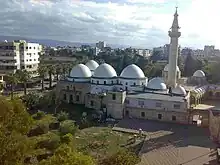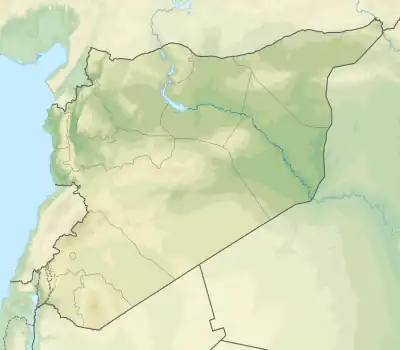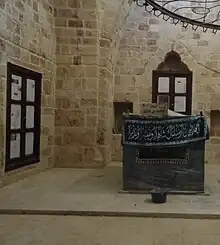| Mosque of Sultan Ibrahim ibn Adham | |
|---|---|
 | |
| Religion | |
| Affiliation | Sunni Islam |
| Province | Latakia Governorate |
| Location | |
| Location | Jableh, Latakia Governorate, Syria |
 Shown within Syria | |
| Geographic coordinates | 35°21′46″N 35°55′27″E / 35.3628990°N 35.9241339°E |
| Architecture | |
| Type | mosque and mausoleum/shrine |
| Style | Seljuk, Mamluk, Ottoman |
| Specifications | |
| Dome(s) | 8 |
| Minaret(s) | 1 |
The Mosque of Sultan Ibrahim ibn Adham is located in the city of Jableh, Latakia Governorate, Syria. The mosque dates back to the Seljuk era and was subsequently improved by the Mamluks and Ottomans, the latter two whose contributions are still present predominantly[1] in the modern building. The mosque was named after Ibrahim ibn Adham, an 8th-century Sufi mystic and Islamic scholar, who is said to be buried in the mosque's shrine.[2]
History
Ibrahim ibn Adham died in a naval campaign against the Byzantines, and was buried in a fort on a Roman island. It alleged that the location of the fort in present-day is the city of Jableh in the Latakia Governorate on the Syrian coast.[3]

Originally at the site of the present building, there was a church, but it was demolished at some point of time. The first structure built over the alleged grave of Ibrahim ibn Adham was a shrine, which was done by the Seljuks as a token of respect for the saint.[4]
During the Mamluk rule, a mosque was built and attached to the shrine, along with a minaret. A fountain and gate was also added to the structure.[5] The current prayer hall of the mosque was completed during this era. Later during Ottoman rule over Syria, the domes of the mosque were built and the minaret was renovated.[6]
Architecture

The mosque has three perpendicular entrances; a northern entrance that leads directly to the open courtyard, a southern entrance that leads to the shrine, and an eastern entrance that leads to a row of warehouses. The eastern entrance also leads to a more modern part of the building. The mosque complex consists of three main features; the prayer hall, the courtyard, and the shrine room.[7]
The prayer hall, dating back to the Mamluk era, is mainly entered from the western side is open to the open courtyard. The walls are 116.5 centimetres thick. The windows on the sides of the prayer hall are identical in dimensions and descriptions, with a width of 120 centimetres and a height of 200 centimetres, each rectangular with two wooden shutters on the inner side. The qibla of the mosque is on the southern side of the prayer hall, and the mihrab and minbar are present there. The minbar is built of old white-gray marble, and it has a small wooden door at its front with two doors engraved with marble decorations.[8]
The shrine room is squarish in shape, with walls of at least 8 metres in base length. The walls are surmounted by an arched dome made of Syrian sandstone. The dome sits on an octagonal base.[9] On its southern wall, there are two identical rectangular openings with two main wooden shutters, between them is an old semicircular mihrab.[10] It is surmounted by a pointed arch, and next to it are two columns, each with a simple muqarnas capital and a square base above the mihrab.[11] The grave of Ibrahim ibn Adham is located at the center of the room.
There is a hammam attached to the mosque complex. The floor of the hammam is paved with fine marble.[12]
Other burial places attributed to Ibrahim ibn Adham
There is a small shrine located in the city of Sur in Oman which is alleged to entomb the remains of Ibrahim ibn Adham.[13] However, this does not match with the tradition in Islamic history that Ibrahim ibn Adham was buried on an island which was under Byzantine Roman control.
See also
References
- ↑ Rem. "جامع السلطان ابراهيم.. معلم ديني وأثري في جبلة". S A N A (in Arabic). Retrieved 2023-11-20.
- ↑ "اكتشف العالم". اكتشف العالم. Retrieved 2023-11-20.
- ↑ "اكتشف العالم". اكتشف العالم. Retrieved 2023-11-20.
- ↑ Rem. "جامع السلطان ابراهيم.. معلم ديني وأثري في جبلة". S A N A (in Arabic). Retrieved 2023-11-20.
- ↑ Rem. "جامع السلطان ابراهيم.. معلم ديني وأثري في جبلة". S A N A (in Arabic). Retrieved 2023-11-20.
- ↑ Rem. "جامع السلطان ابراهيم.. معلم ديني وأثري في جبلة". S A N A (in Arabic). Retrieved 2023-11-20.
- ↑ Rem. "جامع السلطان ابراهيم.. معلم ديني وأثري في جبلة". S A N A (in Arabic). Retrieved 2023-11-20.
- ↑ Rem. "جامع السلطان ابراهيم.. معلم ديني وأثري في جبلة". S A N A (in Arabic). Retrieved 2023-11-20.
- ↑ Rem. "جامع السلطان ابراهيم.. معلم ديني وأثري في جبلة". S A N A (in Arabic). Retrieved 2023-11-20.
- ↑ Rem. "جامع السلطان ابراهيم.. معلم ديني وأثري في جبلة". S A N A (in Arabic). Retrieved 2023-11-20.
- ↑ Rem. "جامع السلطان ابراهيم.. معلم ديني وأثري في جبلة". S A N A (in Arabic). Retrieved 2023-11-20.
- ↑ Rem. "جامع السلطان ابراهيم.. معلم ديني وأثري في جبلة". S A N A (in Arabic). Retrieved 2023-11-20.
- ↑ "Ibrahim Ibn Adham: The prince of Sufis - Inspiring Minds - Folk". Ahram Online. Retrieved 2020-06-04.